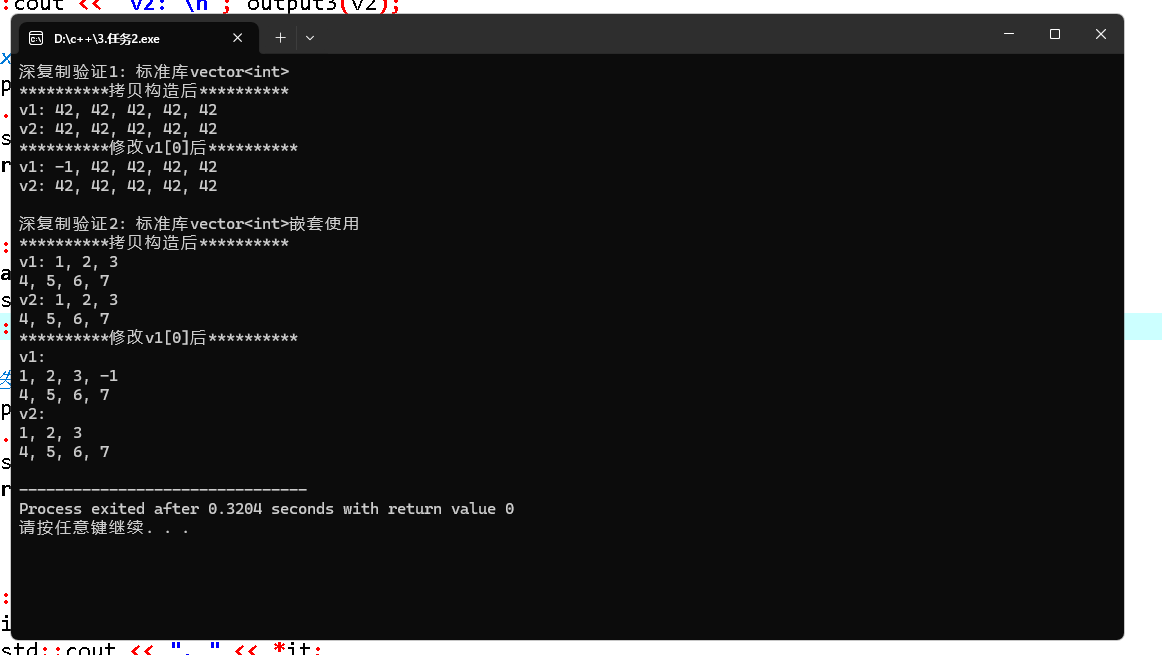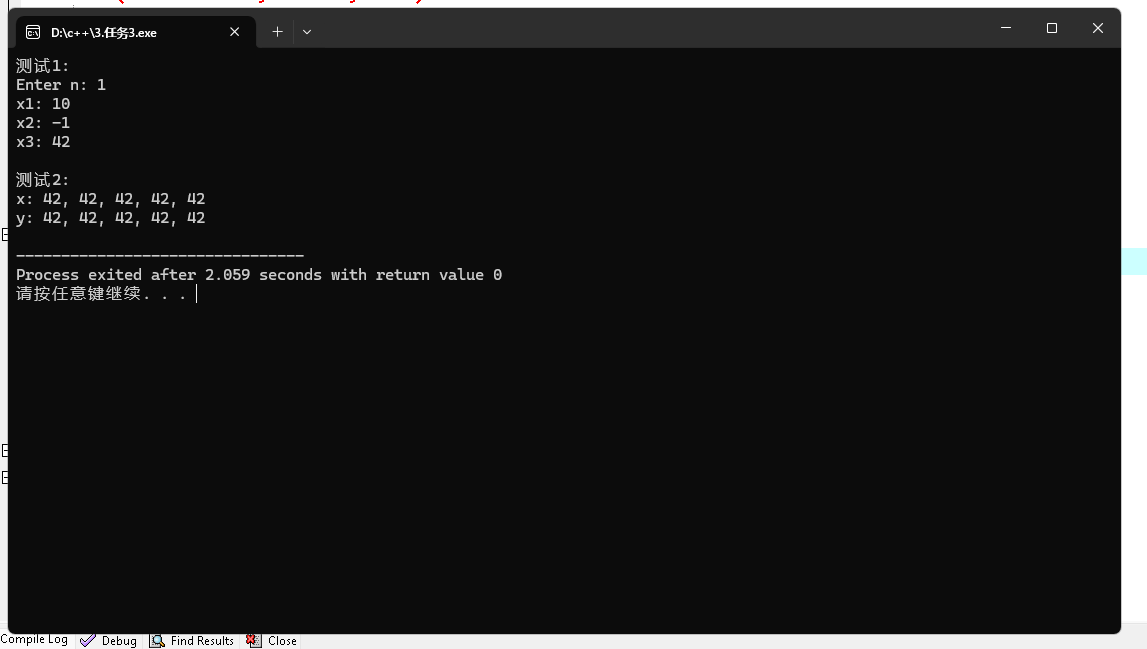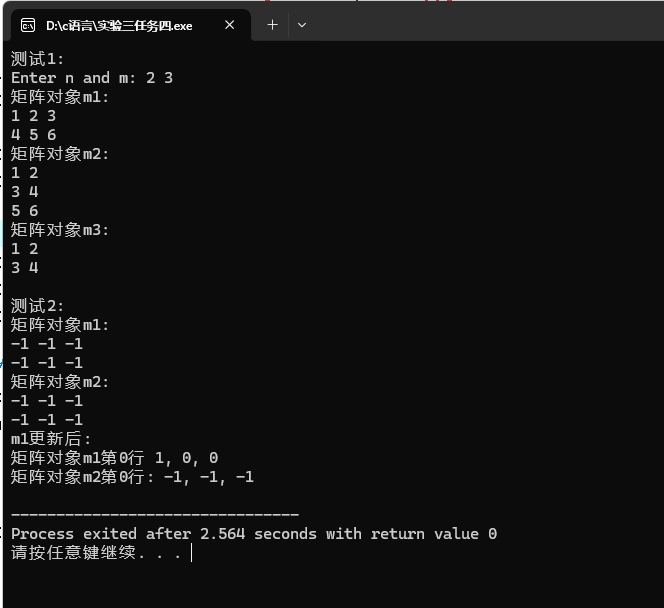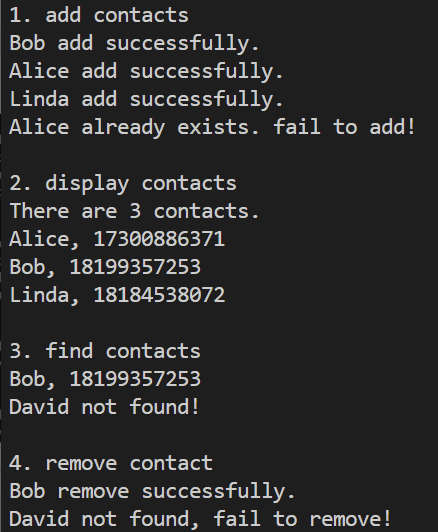实验3
任务1
button.hpp
#pragma once #include <iostream> #include <string> class Button { public: Button(const std::string &label_); const std::string& get_label() const; void click(); private: std::string label; }; Button::Button(const std::string &label_): label{label_} { } inline const std::string& Button::get_label() const { return label; } inline void Button::click() { std::cout << "Button '" << label << "' clicked\n"; }
window.hpp
#pragma once #include <iostream> #include <vector> #include <algorithm> #include "button.hpp" // 窗口类 class Window{ public: Window(const std::string &title_); void display() const; void close(); void add_button(const std::string &label); void click_button(const std::string &label); private: bool has_button(const std::string &label) const; private: std::string title; std::vector<Button> buttons; }; Window::Window(const std::string &title_): title{title_} { buttons.push_back(Button("close")); } inline void Window::display() const { std::string s(40, '*'); std::cout << s << std::endl; std::cout << "window : " << title << std::endl; int cnt = 0; for(const auto &button: buttons) std::cout << ++cnt << ". " << button.get_label() << std::endl; std::cout << s << std::endl; } inline void Window::close() { std::cout << "close window '" << title << "'" << std::endl; click_button("close"); } inline bool Window::has_button(const std::string &label) const { for(const auto &button: buttons) if(button.get_label() == label) return true; return false; } inline void Window::add_button(const std::string &label) { if(has_button(label)) std::cout << "button " << label << " already exists!\n"; else buttons.push_back(Button(label)); } inline void Window::click_button(const std::string &label) { for(auto &button:buttons) if(button.get_label() == label) { button.click(); return; } std::cout << "no button: " << label << std::endl; }
task1.cpp
#include "window.hpp" #include <iostream> void test(){ Window w("Demo"); w.add_button("add"); w.add_button("remove"); w.add_button("modify"); w.add_button("add"); w.display(); w.close(); } int main() { std::cout << "用组合类模拟简单GUI:\n"; test(); }
运行结果

问题1:这个范例中,Window和Button是组合关系吗?
答:是
问题2: bool has_button(const std::string &label) const; 被设计为私有。 思考并回答:
(1)若将其改为公有接口,有何优点或风险?
答:优点:调用范围更广泛,使用更方便:风险:破坏了类的封装性
(2)设计类时,如何判断一个成员函数应为 public 还是 private?(可从“用户是否需要”、“是否仅为内部实现细节”、“是否易破坏对象状态”等角度分析。)
答:如果仅涉及到类内的算法及数据处理,则可设为private;如果类内的成员函数需要频繁从外部调用,则应设为public
问题3:Button的接口const std::string& get_label() const;返回const std::string&。对比以下两种接口设计在性能和安全性方面的差异并精炼陈述。
接口1:const std::string& get_label() const;
接口2:const std::string get_label() const;
答:接口1:直接返回引用,无需进行拷贝,较为高效,但需注意出现悬空引用的情况;接口2:有拷贝开销,效率较低,但无悬空引用风险
问题4:把代码中所有 xx.push_back(Button(xxx))改成 xx.emplace_back(xxx),观察程序是否正常运行;查阅资料,回答两种写法的差别。
答:能正常运行。前者先创建了临时对象再将其拷贝,后者直接在内存空间中构造
任务2
task2.cpp
#include <iostream> #include <vector> void test1(); void test2(); void output1(const std::vector<int> &v); void output2(const std::vector<int> &v); void output3(const std::vector<std::vector<int>>& v); int main() { std::cout << "深复制验证1: 标准库vector<int>\n"; test1(); std::cout << "\n深复制验证2: 标准库vector<int>嵌套使用\n"; test2(); } void test1() { std::vector<int> v1(5, 42); const std::vector<int> v2(v1); std::cout << "**********拷贝构造后**********\n"; std::cout << "v1: "; output1(v1); std::cout << "v2: "; output1(v2); v1.at(0) = -1; std::cout << "**********修改v1[0]后**********\n"; std::cout << "v1: "; output1(v1); std::cout << "v2: "; output1(v2); } void test2() { std::vector<std::vector<int>> v1{{1, 2, 3}, {4, 5, 6, 7}}; const std::vector<std::vector<int>> v2(v1); std::cout << "**********拷贝构造后**********\n"; std::cout << "v1: "; output3(v1); std::cout << "v2: "; output3(v2); v1.at(0).push_back(-1); std::cout << "**********修改v1[0]后**********\n"; std::cout << "v1: \n"; output3(v1); std::cout << "v2: \n"; output3(v2); } // 使用xx.at()+循环输出vector<int>数据项 void output1(const std::vector<int> &v) { if(v.size() == 0) { std::cout << '\n'; return; } std::cout << v.at(0); for(auto i = 1; i < v.size(); ++i) std::cout << ", " << v.at(i); std::cout << '\n'; } // 使用迭代器+循环输出vector<int>数据项 void output2(const std::vector<int> &v) { if(v.size() == 0) { std::cout << '\n'; return; } auto it = v.begin(); std::cout << *it; for(it = v.begin()+1; it != v.end(); ++it) std::cout << ", " << *it; std::cout << '\n'; } // 使用auto for分行输出vector<vector<int>>数据项 void output3(const std::vector<std::vector<int>>& v) { if(v.size() == 0) { std::cout << '\n'; return; } for(auto &i: v) output2(i); }
运行结果:

问题1:测试模块1中这两行代码分别完成了什么构造? v1、v2 各包含多少个值为 42 的数据项?
答:第一行为填充构造函数,包含5个;第二行为拷贝构造函数,也有5个。
问题2:测试模块2中这两行代码执行后, v1.size()、v2.size()、v1[0].size()分别是多少?
答:v1.size()为2,v2.size()为2,v1[0].size()为3。
问题3:测试模块1中,把v1.at(0) = -1;写成v1[0] = -1;能否实现同等效果?两种用法有何区别?
答:能。前者会做下标合法性检查,后者不会。
问题4:测试模块2中执行v1.at(0).push_back(-1);后
(1) 用以下两行代码,能否输出-1?为什么?
能,执行后v1[0]的vector的size值会加1
(2)r定义成用const &类型接收返回值,在内存使用上有何优势?有何限制?
答:优势:节省了拷贝元素的内存;限制:只能进行只读操作。
问题5:观察程序运行结果,反向分析、推断:
(1) 标准库模板类vector的复制构造函数实现的是深复制还是浅复制?
答:深复制
(2) vector<T>::at() 接口思考: 当 v是vector<int> 时,v.at(0)返回值类型是什么?当v是constvector<int>时,v.at(0)返回值类型又是什么?据此推断 at()是否必须提供带 const 修饰的重载版本?
答:当 v是vector<int> 时,v.at(0)返回值类型是int &;当v是constvector<int>时,v.at(0)返回值类型是const int &;推断出at()必须提供带 const 修饰的重载版本。
任务3
vectorInt.hpp
#pragma once #include <iostream> // 动态int数组对象类 class vectorInt{ public: vectorInt(); vectorInt(int n_); vectorInt(int n_, int value); vectorInt(const vectorInt &vi); ~vectorInt(); int size() const; int& at(int index); const int& at(int index) const; vectorInt& assign(const vectorInt &vi); int* begin(); int* end(); const int* begin() const; const int* end() const; private: int n; // 当前数据项个数 int *ptr;// 数据区 }; vectorInt::vectorInt():n{0}, ptr{nullptr} { } vectorInt::vectorInt(int n_): n{n_}, ptr{new int[n]} { } vectorInt::vectorInt(int n_, int value): n{n_}, ptr{new int[n_]} { for(auto i = 0; i < n; ++i) ptr[i] = value; } vectorInt::vectorInt(const vectorInt &vi): n{vi.n}, ptr{new int[n]} { for(auto i = 0; i < n; ++i) ptr[i] = vi.ptr[i]; } vectorInt::~vectorInt() { delete [] ptr; } int vectorInt::size() const { return n; } const int& vectorInt::at(int index) const { if(index < 0 || index >= n) { std::cerr << "IndexError: index out of range\n"; std::exit(1); } return ptr[index]; } int& vectorInt::at(int index) { if(index < 0 || index >= n) { std::cerr << "IndexError: index out of range\n"; std::exit(1); } return ptr[index]; } vectorInt& vectorInt::assign(const vectorInt &vi) { if(this == &vi) return *this; int *ptr_tmp; ptr_tmp = new int[vi.n]; for(int i = 0; i < vi.n; ++i) ptr_tmp[i] = vi.ptr[i]; delete[] ptr; n = vi.n; ptr = ptr_tmp; return *this; } int* vectorInt::begin() { return ptr; } int* vectorInt::end() { return ptr+n; } const int* vectorInt::begin() const { return ptr; } const int* vectorInt::end() const { return ptr+n; }
task3.cpp
#include "vectorInt.hpp" #include <iostream> void test1(); void test2(); void output1(const vectorInt &vi); void output2(const vectorInt &vi); int main() { std::cout << "测试1: \n"; test1(); std::cout << "\n测试2: \n"; test2(); } void test1() { int n; std::cout << "Enter n: "; std::cin >> n; vectorInt x1(n); for(auto i = 0; i < n; ++i) x1.at(i) = (i+1)*10; std::cout << "x1: "; output1(x1); vectorInt x2(n, 42); vectorInt x3(x2); x2.at(0) = -1; std::cout << "x2: "; output1(x2); std::cout << "x3: "; output1(x3); } void test2() { const vectorInt x(5, 42); vectorInt y; y.assign(x); std::cout << "x: "; output2(x); std::cout << "y: "; output2(y); } // 使用xx.at()+循环输出vectorInt对象数据项 void output1(const vectorInt &vi) { if(vi.size() == 0) { std::cout << '\n'; return; } std::cout << vi.at(0); for(auto i = 1; i < vi.size(); ++i) std::cout << ", " << vi.at(i); std::cout << '\n'; } // 使用迭代器+循环输出vectorInt对象数据项 void output2(const vectorInt &vi) { if(vi.size() == 0) { std::cout << '\n'; return; } auto it = vi.begin(); std::cout << *it; for(it = vi.begin()+1; it != vi.end(); ++it) std::cout << ", " << *it; std::cout << '\n'; }
运行结果:
问题1:当前验证性代码中,vectorInt接口assign实现是安全版本。如果把assign实现改成版本2,逐条指出版本 2存在的安全隐患和缺陷。(提示:对比两个版本,找出差异化代码,加以分析)
答:可能出现访问空指针的问题;没有判断自赋值;返回值类型错误;可能出现内存泄漏和悬挂指针的问题。
问题2:当前验证性代码中,重载接口at内部代码完全相同。若把非 const 版本改成如下实现,可消除重复并遵循“最小化接口”原则(未来如需更新接口,只更新const接口,另一个会同步)。
查阅资料,回答:
(1)static_cast<const vectorInt*>(this)的作用是什么?转换前后this的类型分别是什么?转换目的?
答:作用是将非 const 的 this 指针强制转换成const vectorInt* 类型的指针,从而让当前对象可以调用const 版本的 at 成员函数。转换前 this 的类型是 vectorInt*,转换后的类型是 const vectorInt*。转换目的:强制触发 const 版本 at 函数的调用,实现代码复 用,保证逻辑一致性:让非 const 版本的 at 完全复用 const 版本的索引检查、元素访问逻辑,避免两处代码重复维护,符合“最小化接口”原则。
(2)const_cast<int&>的作用是什么?转换前后的返回类型分别是什么?转换目的?
答:作用是将const int&类型的返回值转换为int&类型,匹配非 const 版本 at 的返回值要求。转换前const 版本 at 的返回类型是 const int&,转换后返回类型是 int&。目的:使之能够进行修改操作。
问题3:vectorInt类封装了begin()和end()的const/非const接口。
(1)以下代码片段,分析编译器如何选择重载版本,并总结这两种重载分别适配什么使用场景。
答:会优先选择非const对象。非const对象适配需要对其本身数据进行操作的场景,const对象适配只读操作。
问题4:以下两个构造函数及assign接口实现,都包含内存块的赋值和复制操作。使用算法库<algorithm>改成如下写法是否可以?回答这3行更新代码的功能。
答:可以。fill_n(ptr, n, value)函数能将值value批量赋值给ptr指向的连续内存块中前n个int元素,实现了动态数组的初始化填充;copy_n(vi.ptr, vi.n, ptr)函数能将vi.ptr指向的内存块中拷贝前n个元素到新内存块中;copy_n(vi.ptr, vi.n, ptr_tmp)将vi.ptr指向的内存块中拷贝前n个元素到临时内存块中。
任务4
matrix.hpp
#pragma once // 类Matrix声明 class Matrix { public: Matrix(int rows_, int cols_, double value = 0); // 构造rows_*cols_矩阵对象, 初值value Matrix(int rows_, double value = 0); // 构造rows_*rows_方阵对象, 初值value Matrix(const Matrix &x); // 深复制 ~Matrix(); void set(const double *pvalue, int size); // 按行复制pvalue指向的数据,要求size=rows*cols,否则报错退出 void clear(); // 矩阵对象数据项置0 const double& at(int i, int j) const; // 返回矩阵对象索引(i,j)对应的数据项const引用(越界则报错后退出) double& at(int i, int j); // 返回矩阵对象索引(i,j)对应的数据项引用(越界则报错后退出) int rows() const; // 返回矩阵对象行数 int cols() const; // 返回矩阵对象列数 void print() const; // 按行打印数据 private: int n_rows; // 矩阵对象内元素行数 int n_cols; // 矩阵对象内元素列数 double *ptr; // 数据区 };
matrix.cpp
#include <iostream> #include <vector> #include <cstdlib> #include <algorithm> #include "matrix.hpp" Matrix::Matrix(int rows_, int cols_, double value){ n_rows=rows_,n_cols=cols_; ptr=new double[n_rows*n_cols]; int i; for(i=0;i<n_rows*n_cols;i++){ ptr[i]=value; } } Matrix::Matrix(int rows_, double value){ n_rows=rows_,n_cols=rows_; ptr=new double[n_rows*n_cols]; int i; for(i=0;i<n_rows*n_cols;i++){ ptr[i]=value; } } Matrix::Matrix(const Matrix &x){ n_rows=x.rows(),n_cols=x.cols(); ptr=new double[n_rows*n_cols]; int i; for(i=0;i<n_rows*n_cols;i++){ ptr[i]=x.ptr[i]; } } Matrix::~Matrix(){}; void Matrix::set(const double *pvalue, int size){ if(size!=n_rows*n_cols){ std::cout<<"错误\n"; } else{ int i; for(i=0;i<size;i++){ ptr[i]=pvalue[i]; } } } void Matrix::clear(){ for(int i=0;i<n_rows*n_cols;i++){ ptr[i]=0; } } const double& Matrix::at(int i, int j) const{ if((i*n_cols+j)>=n_rows*n_cols){ std::cout<<"错误\n"; } else{ return ptr[i*n_cols+j]; } } double& Matrix::at(int i, int j){ if((i*n_cols+j)>=n_rows*n_cols){ std::cout<<"错误\n"; } else{ return ptr[i*n_cols+j]; } } int Matrix::rows() const{ return n_rows; } int Matrix::cols() const{ return n_cols; } void Matrix::print() const{ int i,j; for(i=0;i<n_rows;i++){ for(j=0;j<n_cols;j++){ std::cout<<ptr[i*n_cols+j]<<" "; } std::cout<<"\n"; } }
task4.cpp
#include <iostream> #include <cstdlib> #include "matrix.hpp" void test1(); void test2(); void output(const Matrix &m, int row_index); int main() { std::cout << "测试1: \n"; test1(); std::cout << "\n测试2: \n"; test2(); } void test1() { double x[1000] = {1, 2, 3, 4, 5, 6, 7, 8, 9, 10}; int n, m; std::cout << "Enter n and m: "; std::cin >> n >> m; Matrix m1(n, m); // 创建矩阵对象m1, 大小n×m m1.set(x, n*m); // 用一维数组x的值按行为矩阵m1赋值 Matrix m2(m, n); // 创建矩阵对象m2, 大小m×n m2.set(x, m*n); // 用一维数组x的值按行为矩阵m1赋值 Matrix m3(n); // 创建一个n×n方阵对象 m3.set(x, n*n); // 用一维数组x的值按行为矩阵m3赋值 std::cout << "矩阵对象m1: \n"; m1.print(); std::cout << "矩阵对象m2: \n"; m2.print(); std::cout << "矩阵对象m3: \n"; m3.print(); } void test2() { Matrix m1(2, 3, -1); const Matrix m2(m1); std::cout << "矩阵对象m1: \n"; m1.print(); std::cout << "矩阵对象m2: \n"; m2.print(); m1.clear(); m1.at(0, 0) = 1; std::cout << "m1更新后: \n"; std::cout << "矩阵对象m1第0行 "; output(m1, 0); std::cout << "矩阵对象m2第0行: "; output(m2, 0); } // 输出矩阵对象row_index行所有元素 void output(const Matrix &m, int row_index) { if(row_index < 0 || row_index > m.rows()) { std::cerr << "IndexError: row index out of range\n"; std::exit(1); } std::cout << m.at(row_index, 0); for(int j = 1; j < m.cols(); ++j) std::cout << ", " << m.at(row_index, j); std::cout << '\n'; }
运行结果

任务5
contact.hpp
#pragma once #include <iostream> #include <string> // 联系人类 class Contact { public: Contact(const std::string &name_, const std::string &phone_); const std::string &get_name() const; const std::string &get_phone() const; void display() const; private: std::string name; // 必填项 std::string phone; // 必填项 }; Contact::Contact(const std::string &name_, const std::string &phone_):name{name_}, phone{phone_} { } const std::string& Contact::get_name() const { return name; } const std::string& Contact::get_phone() const { return phone; } void Contact::display() const { std::cout << name << ", " << phone; }
contactBook.hpp
# pragma once #include <iostream> #include <string> #include <vector> #include <algorithm> #include "contact.hpp" // 通讯录类 class ContactBook { public: void add(const std::string &name, const std::string &phone); // 添加联系人 void remove(const std::string &name); // 移除联系人 void find(const std::string &name) const; // 查找联系人 void display() const; // 显示所有联系人 size_t size() const; private: int index(const std::string &name) const; // 返回联系人在contacts内索引,如不存在,返回-1 void sort(); // 按姓名字典序升序排序通讯录 private: std::vector<Contact> contacts; }; void ContactBook::add(const std::string &name, const std::string &phone) { if(index(name) == -1){ contacts.push_back(Contact(name, phone)); std::cout << name << " add successfully.\n"; sort(); return; } std::cout << name << " already exists. fail to add!\n"; } void ContactBook::remove(const std::string &name) { int i = index(name); if(i == -1) { std::cout << name << " not found, fail to remove!\n"; return; } contacts.erase(contacts.begin()+i); std::cout << name << " remove successfully.\n"; } void ContactBook::find(const std::string &name) const { int i = index(name); if(i == -1) { std::cout << name << " not found!\n"; return; } contacts[i].display(); std::cout << '\n'; } void ContactBook::display() const { for(auto &c: contacts) { c.display(); std::cout << '\n'; } } size_t ContactBook::size() const { return contacts.size(); } // 待补足1:int index(const std::string &name) const;实现 // 返回联系人在contacts内索引; 如不存在,返回-1 int ContactBook::index(const std::string &name) const { for (size_t i = 0; i < contacts.size(); ++i) { if (contacts[i].get_name() == name) { return static_cast<int>(i); } } return -1; } // 待补足2:void ContactBook::sort();实现 // 按姓名字典序升序排序通讯录 void ContactBook::sort() { std::sort(contacts.begin(), contacts.end(), [](const Contact &c1, const Contact &c2) { return c1.get_name() < c2.get_name(); }); }
task5.cpp
#include "contactBook.hpp" void test() { ContactBook contactbook; std::cout << "1. add contacts\n"; contactbook.add("Bob", "18199357253"); contactbook.add("Alice", "17300886371"); contactbook.add("Linda", "18184538072"); contactbook.add("Alice", "17300886371"); std::cout << "\n2. display contacts\n"; std::cout << "There are " << contactbook.size() << " contacts.\n"; contactbook.display(); std::cout << "\n3. find contacts\n"; contactbook.find("Bob"); contactbook.find("David"); std::cout << "\n4. remove contact\n"; contactbook.remove("Bob"); contactbook.remove("David"); } int main() { test(); }
运行结果






 浙公网安备 33010602011771号
浙公网安备 33010602011771号